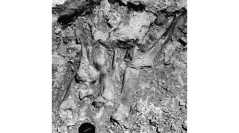

 Geodiversitas
27 (4) - Pages 793-808
Geodiversitas
27 (4) - Pages 793-808The taphonomy of the late Miocene fossiliferous deposit of Akkașdağı (Anatolia, Turkey) is presented. The study of bone surface shows few occurrences of weathering and carnivore action. Dissolution marks (roots, fungi and micro-organisms) are the most abundant traces found on the bone surface. The study of bone orientation and some field observations testify to the existence of a predominant direction. Water is considered the main accumulating agent. Nevertheless, the study of surface abrasion shows that bones did not travel from a long distance. The events that contributed to the formation of the fossiliferous site are reconstructed: the hypothesis of catastrophic mortality causes is held as the most probable. Animals would have been killed by toxic emanations of volcanic origins. Their remains were subjected to the action of disarticulating agents, especially carnivores. Finally, they would have been transported by the water to some holes in the ground and covered quickly by tufaceous sediments.
Mammalia, large mammals, taphonomy, weathering, late Miocene, Akkașdağı, Central Anatolia, Turkey